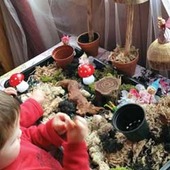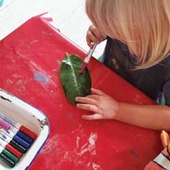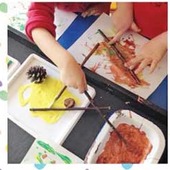by autumn to inspire learning opportunities.

It is that time of year when nature is especially generous in producing an abundance of resources that children can explore, create and play with. Roseacre Playgroup in Shepperton, Surrey, has been taking full advantage of these natural treasures.
Since moving to new premises, the Roseacre staff have been overwhelmed by the scope their new outdoor environment offers. Having previously operated from the local school with a small paved area outside, the playgroup is now in situated the local cricket pavilion with access to a playing field surrounded by trees.
'When we moved here we woke up and went "wow",' recalls deputy manager Lynda Carter. 'Prior to this we had been in the grounds of a school for 24 years, where we had some use of the fields but not the freedom that we have now.'
Over the past few weeks the children at Roseacre have been venturing out into their new space to collect autumnal objects and using them in some inventive and imaginative ways.

CONKERS, LEAVES AND STICKS
Conkers, it seems, have various mathematical uses. The children used them to make a set of speckled owls, lined them up on a log and made up a counting rhyme to the tune of Five Green and Speckled Frogs. Staff also put a large supply in the maths area. 'The children loved that because we had loads of them,' says Mrs Carter. 'They were weighing them and filling them into plastic tubes.'
Leaves proved to be especially versatile, prompting many activities. The children made leaf crowns, which were later used as inspiration for music and movement. Deep green beech leaves turned out to be the perfect shape for owl wings and dried brown sycamore leaves were great for making stick puppets.
 Leaves also served as an unlikely tool for encouraging mark-making. 'We have lovely big glossy leaves here and the children used glass paint pens to draw on them,' explains Mrs Carter. 'Children who never draw were drawing on the leaves and mark-making on the veins.'
Leaves also served as an unlikely tool for encouraging mark-making. 'We have lovely big glossy leaves here and the children used glass paint pens to draw on them,' explains Mrs Carter. 'Children who never draw were drawing on the leaves and mark-making on the veins.'
She highlights the impact the outdoor environment has had on their general practice and approach to planning. 'We've been really resourceful with all the things that surround us. It's the outside that tells us what we're going to do. So, for example, we had such a lovely day the other week that we decided to spend the morning out on the veranda and then the children found things on the floor, like sycamore seeds, and started using them as paintbrushes.'
 This child-initiated activity led on to further experimentation of painting with sticks, pine cones, conkers and apples. The children studied the surrounding trees with binoculars and experimented with colour mixing to create autumn-coloured paints. They even put some conkers, pinecones and paint in a salad spinner to see what would happen.
This child-initiated activity led on to further experimentation of painting with sticks, pine cones, conkers and apples. The children studied the surrounding trees with binoculars and experimented with colour mixing to create autumn-coloured paints. They even put some conkers, pinecones and paint in a salad spinner to see what would happen.
'Some things you plan and some things just happen. It makes every day different,' says Mrs Carter. 'The other morning when we came in it the whole veranda was covered in spider webs, so we thought we'd have a look at those.'
A SMALL WORLD
These fantastic natural resources have provided inspiration for small-world play. The children took conkers outside and loaded them into cars and trucks. They also created a mini habitat for woodland animal figurines.
Mrs Carter explains, 'We sat in a circle and the children put the natural materials one by one into a tray. Then we put the animals in, like a hedgehog in the leaves and a squirrel up a tree, and we talked about them.
'Because we had a lot of materials left over, like wood and logs, we used these to create a fairy garden. We used bark and moss, earth, glass pebbles, fairies and flower pots. We also got some Icelandic moss sent to us in different colours. So they had different textures to play with in there. The woodland animals were in there too and actually it was a favourite with the boys. So it's all linked. It's been so lovely this term.'
SEASONAL BOOKS, SONGS AND GAMES
 Stick Man by Julia Donaldson and Axel Scheffler - Stick Man gets lost and has to find his way home again.
Stick Man by Julia Donaldson and Axel Scheffler - Stick Man gets lost and has to find his way home again.
Leaves by David Ezra Stein - a little bear experiences autumn for the first time.
 Fletcher and the Falling Leaves by Julia Rawlinson and Tiphanie Beeke - Fletcher the Fox's favourite tree is losing its leaves and Fletcher is upset to find that he cannot help it.
Fletcher and the Falling Leaves by Julia Rawlinson and Tiphanie Beeke - Fletcher the Fox's favourite tree is losing its leaves and Fletcher is upset to find that he cannot help it.
Let it Fall by Maryann Cocca-Leffler - rhythmical, rhyming text about autumn.
 Squirrel's Autumn Search by Anita Loughrey and Daniel Howarth - a squirrel buries his acorns and then cannot remember where he put them.
Squirrel's Autumn Search by Anita Loughrey and Daniel Howarth - a squirrel buries his acorns and then cannot remember where he put them.
Thinking About the Seasons: Autumn by Clare Collinson - full-colour information book for young children.
 Not a Stick by Antoinette Portis - when a stick is not a stick.
Not a Stick by Antoinette Portis - when a stick is not a stick.
Stanley's Stick by Neal Layton and John Hegley - stick in hand, Stanley takes a leap into an imaginative world where anything is possible.
Songs, rhymes and games
Find an autumn song at www.bbc.co.uk/cbeebies/presenters/songs/presenters-autumn-song.
Find action rhyme Red and Yellow and Orange and Brown with accompanying music at www.letsplaykidsmusic.com/red-and-yellow-and-orange-and-brown-songs-for-autumn.
Play 'musical leaves'. Ask the children to float around a large space like leaves in the breeze and to lie flat on the floor when the music stops.
Play 'capture the conkers'. Divide the children into two teams of four. Give one team a tub of conkers and the other a tub of acorns. The teams stand at opposite ends of a large space. When the whistle blows, the children run to the opposing team's tub and grab one conker/acorn and take it back to their own tub. They continue until the whistle blows again. The winning team is the one that captures the most objects from their opponent's tub.
MORE IDEAS FOR AUTUMN
Build a den for a mouse
Take the children out to a woodland area where there are plenty of loose sticks and branches on the ground. Divide them children into small groups and challenge them to build a den for a mouse. Explain it should have walls, a roof and an entrance. Inside, there should be room to sit and sleep. Help the children choose appropriately sized sticks, roofing materials that will keep the rain off and comfortable bedding.
Make stained leaf windows
Place a large flat light-coloured leaf on a piece of sugar paper and draw around it with a pencil. Use this as a guide to cut the leaf shape out of the paper, leaving a small margin around the edge. Use Sellotape to stick the leaf to the paper so that it fills the hole. Stick it on a window so the light shines through the leaf.
Use natural rhythm
Use natural objects to make music. For instance: beat on logs with sticks; fill containers with acorns and conkers and shake them; place spiky horse chestnut casings inside tins and shimmy them around; make percussion instruments out of sticks; scrunch dried leaves.
Create a leaf collage
Collect a range of colourful leaves and create a large-scale patterned collage.
Go on a sensory scavenger hunt
Challenge the children to seek out autumnal objects according to sensory characteristics. For example: something that rolls, rattles, floats, scrunches when squeezed, is prickly to the touch, flutters and twists when dropped, and tastes good when roasted.
RESOURCES
- Glass paint pens (www.bakerross.co.uk).
- Natural objects and materials for creating fairy gardens (www.cosydirect.com).
- Artificial leaves made from fabric, corrugated card and paper (www.earlyyearsresources.co.uk).
- Woodland scene small-world kit (www.yellow-door.net).
- Tree layer puzzle depicting the changing seasons (www.earlyyearsdirect.com).
- Leaf-shaped glass pebbles (www.reflectionsonlearning.co.uk).
- Natural sticks, pine cones, moss, mopani wood, tree building blocks and sensory treasure baskets (www.tts-group.co.uk).
LEARNING OPPORTUNITIES
PSED: Confident to try new activities and speak in a familiar group.
CL: Follows instructions involving several ideas.
PD: Moves confidently in a range of ways, safely negotiating space; handles equipment and tools effectively, including pencils for writing.
L: Listens to and joins in with stories and poems.
M: Counts reliably and says the number that is one less than a given number; uses everyday language to talk about size, weight and capacity.
UW: Talks about things they have observed, such as objects; develops an understanding of growth, decay and change.
EAD: Makes music and dances; explores materials and techniques, experimenting with colour, design, texture, form and function; represents own ideas through art, music, dance and play.
Marianne Sargent is a writer specialising in early years education and a former foundation stage teacher and primary and early years lecturer









